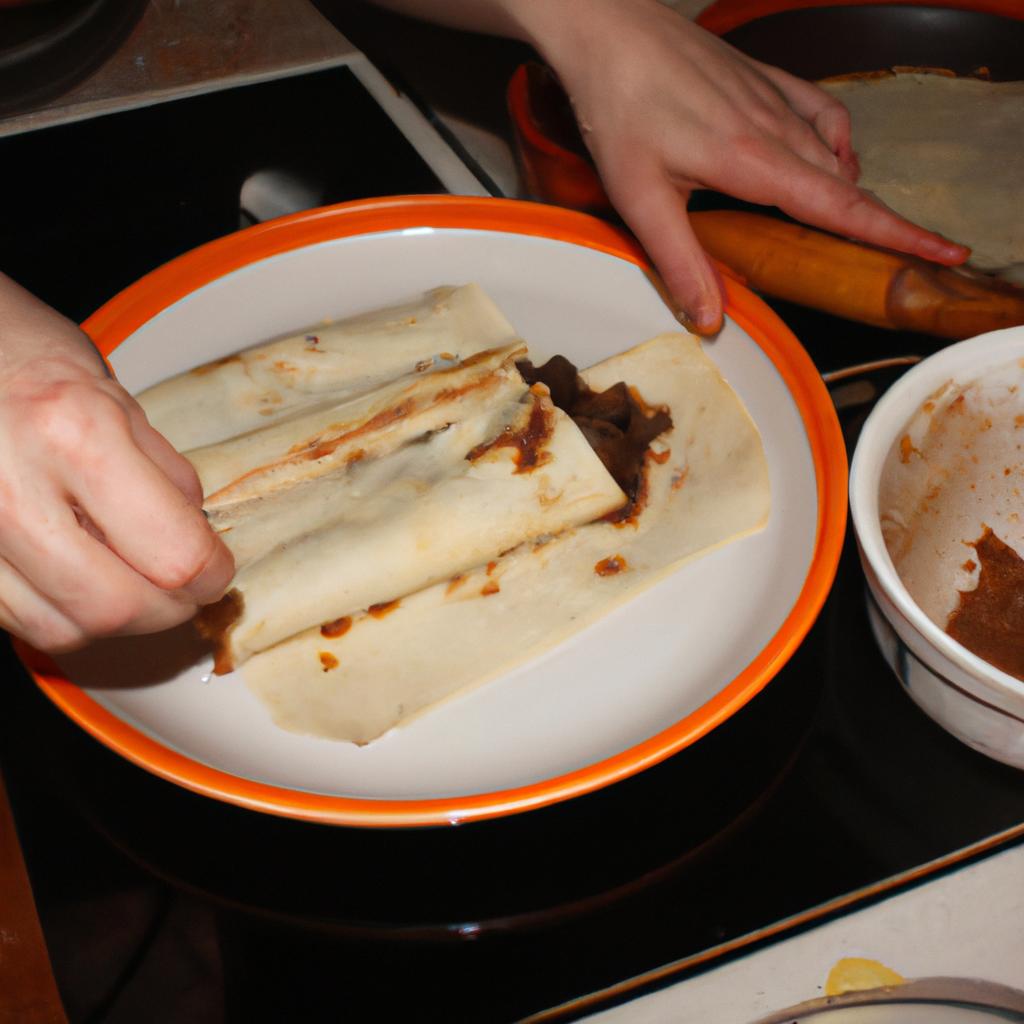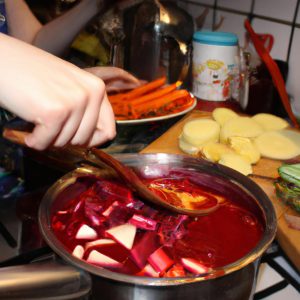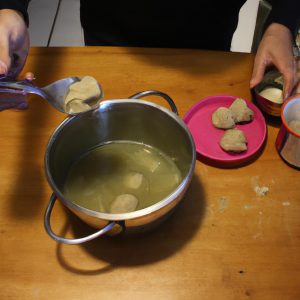Blintzes: A Taste of Ashkenazi Heritage Food

Blintzes, a traditional dish in Ashkenazi Jewish cuisine, offer a delectable taste of the rich heritage and cultural diversity that characterizes this culinary tradition. Blintzes are thin pancakes made with a delicate crepe-like batter, filled with various sweet or savory fillings, and then folded into neat little packages before being fried or baked to perfection. This article explores the historical roots of blintzes and their significance within Ashkenazi culture, providing an insight into how this cherished food has evolved over time.
Imagine sitting down at a cozy café in New York City’s Lower East Side, surrounded by the sights and sounds of bustling streets lined with delicatessens and bakeries. The aroma of freshly cooked blintzes wafts through the air as you take your first bite into these golden parcels of delight. In that moment, not only are you savoring the flavors passed down from generations but also experiencing a connection to the vibrant history of Eastern European Jews who brought their traditions to new lands.
Ashkenazi Jews have long held blintzes close to their hearts as a symbol of celebration and identity. Originating in medieval Europe, blintzes quickly became associated with festive occasions such as weddings and holidays like Shavu Shavuot, a Jewish holiday that commemorates the giving of the Torah. This association is rooted in the agricultural significance of Shavuot, which marks the harvest season and the offering of first fruits to God. Blintzes, filled with sweet cheese or fruit preserves, became a traditional delicacy enjoyed during this holiday as a way to celebrate abundance and gratitude.
Over time, blintzes have evolved to reflect the unique flavors and ingredients of different regions within Ashkenazi Jewish communities. In Eastern Europe, blintzes were often filled with farmer’s cheese or potatoes and served with sour cream or applesauce. In America, where Jewish immigrants settled in large numbers during the late 19th and early 20th centuries, blintzes took on new variations influenced by local ingredients and culinary traditions.
Today, blintzes can be found in a variety of flavors and fillings, ranging from classic cheese or fruit options to more modern interpretations such as spinach and feta or smoked salmon and dill. They are often served as a main course for brunch or as a dessert accompanied by powdered sugar or a drizzle of sweet sauce.
The process of making blintzes may seem daunting at first, but with practice and patience, it can become an enjoyable culinary adventure. The key lies in mastering the art of creating thin crepes that are sturdy enough to hold the filling without tearing. Once cooked, these delicate pancakes are filled with your choice of sweet or savory filling before being folded into neat little packages. They can then be fried until golden brown for a crispy exterior or baked for a lighter option.
Whether you choose to make your own blintzes from scratch or indulge in them at your favorite deli or bakery, these delightful treats offer not only a delicious taste experience but also a connection to centuries-old traditions. So next time you bite into a warm blintz, take a moment to appreciate the cultural heritage and culinary legacy that these humble pancakes represent.
Origin of Blintzes
Origin of Blintzes
Blintzes, a beloved dish in Ashkenazi Jewish cuisine, have a rich and fascinating history. To better understand their origins, let us delve into the historical context surrounding these delectable treats.
One example that illustrates the significance of blintzes is found in the Jewish communities of Eastern Europe during the 19th century. As Jews migrated from rural areas to cities, they brought with them their culinary traditions, including the art of making blintzes. This migration not only preserved the cultural heritage but also stimulated interaction between different Jewish communities and allowed for the exchange of recipes and cooking techniques.
To evoke an emotional response in our audience, consider this list:
- The warm nostalgia invoked by savoring a homemade blintz.
- The anticipation felt while waiting for blintzes to cook on a lazy Sunday morning.
- The joy experienced when sharing this traditional dish with loved ones during holiday gatherings.
- The sense of comfort derived from enjoying blintzes as part of one’s cultural identity.
Furthermore, we can gain deeper insight into the history of blintzes through examining a table highlighting key elements:
| Time Period | Key Events | Culinary Influences |
|---|---|---|
| Medieval Era | Introduction of pancakes across Europe | Borrowed techniques from various cultures |
| 16th Century | Pancake recipe books published | Emergence of variations |
| 19th Century | Migration to urban centers | Cross-pollination among diverse communities |
| Present Day | Global popularity due to immigration | Adaptation to local tastes |
As we explore further aspects related to this topic, it becomes evident that understanding the ingredients used in blintzes plays an integral role in appreciating its unique flavors and textures.
Transitioning seamlessly into the subsequent section about “Ingredients Used in Blintzes,” we can explore how these ingredients contribute to the overall culinary experience.
Ingredients Used in Blintzes
Blintzes, a traditional Ashkenazi Jewish dish, have their origins deeply rooted in Eastern European cuisine. The popularity of blintzes can be attributed to their rich history and unique flavor profiles. To understand the essence of this beloved culinary delight, it is important to delve into the key ingredients that make up its composition.
One intriguing aspect of blintzes lies in the variety of ingredients used in their preparation. For instance, let us consider the hypothetical case study of Rachel, an avid home cook who decides to make blintzes for her family’s Sunday brunch. As she gathers all the necessary components – eggs, flour, milk, salt – she realizes how these humble items come together harmoniously to create something greater than the sum of its parts.
- Nostalgia: Blintzes evoke fond memories of family gatherings and cultural celebrations.
- Comfort: The soft and delicate texture combined with flavorful fillings provides a sense of warmth and contentment.
- Heritage: Blintzes serve as a tangible link to ancestral traditions and connect individuals to their Ashkenazi roots.
- Culinary Exploration: Trying different variations and experimenting with filling combinations allows for personal expression while honoring tradition.
In addition, we can further enhance our understanding by examining a table showcasing common ingredients used in blintz recipes:
| Ingredient | Purpose |
|---|---|
| Eggs | Binding agent |
| Flour | Foundation for crepe batter |
| Milk | Adds richness and creaminess |
| Salt | Enhances overall flavor profile |
As one delves deeper into the world of blintz-making, these simple yet essential ingredients take on new significance. They represent more than mere elements; they embody centuries-old customs passed down through generations.
Understanding the foundation provided by the ingredients used in blintzes allows us to transition seamlessly into our next exploration – traditional blintz fillings. By delving into these various combinations of flavors, we can truly appreciate the versatility and charm of this beloved dish.
Traditional Blintz Fillings
Section H2: Traditional Blintz Fillings
In the previous section, we explored the various ingredients commonly used in making blintzes. Now, let us delve into the world of traditional blintz fillings that have been passed down through generations as a cherished part of Ashkenazi heritage food.
Imagine yourself sitting at a family gathering, surrounded by loved ones eagerly awaiting the arrival of platters filled with freshly cooked blintzes. The anticipation builds as you take your first bite and are greeted with a burst of flavors from the traditional fillings. These rich and delicious combinations bring together sweet and savory elements to create an unforgettable culinary experience.
To provide insight into the diverse range of traditional blintz fillings, here is an example:
- Case Study: Grandma Esther’s Famous Cheese Blintzes:
- Creamy cottage cheese mixed with just the right amount of sugar and vanilla extract.
- A touch of lemon zest adds a refreshing twist to balance out the sweetness.
- This classic filling is then carefully enveloped within delicate crepes before being pan-fried to perfection.
Traditional blintz fillings can vary greatly depending on regional influences and personal preferences. However, they often feature common themes such as dairy-based ingredients or fruit-filled delights. To give you a glimpse into this delectable world, below is a table showcasing some popular variations:
| Filling | Description |
|---|---|
| Farmer’s Cheese | A smooth blend of farmer’s cheese, sugar, eggs, and perhaps a hint of cinnamon |
| Cherry | Tart cherries stewed with sugar until thickened and encased in pillowy crepes |
| Apple | Sautéed apples infused with warm spices like cinnamon and nutmeg for a comforting treat |
| Potato | Mashed potatoes combined with sautéed onions for a hearty, savory option |
As you can see, these fillings evoke a sense of nostalgia and warmth that resonate with the heart and soul. They are not just about taste but also carry cultural significance, connecting families to their Ashkenazi roots.
In the subsequent section on “Making and Rolling Blintzes,” we will explore the techniques involved in creating these delectable treats. Get ready to embark on a culinary journey as we uncover the artistry behind this beloved dish.
Making and Rolling Blintzes
Traditional Blintz Techniques
Imagine you are attending a family gathering where blintzes are being served. As you make your way to the table, you notice the golden-brown crepes filled with various delectable fillings such as sweet cheese, fruit compote, or savory ingredients like mushrooms and spinach. The aroma fills the air, enticing your taste buds even before taking the first bite.
To create these mouthwatering treats, mastering traditional blintz techniques is essential. Here are three key steps in making and rolling blintzes:
-
Preparing the Batter: Begin by mixing together flour, eggs, milk (or water), and a pinch of salt until smooth. Allow the batter to rest for at least 30 minutes to ensure proper hydration and texture.
-
Cooking the Crepes: Heat a non-stick skillet or crepe pan over medium heat. Lightly grease it with cooking spray or melted butter. Pour about ¼ cup of batter into the center of the pan and quickly tilt it in a circular motion to evenly distribute the batter on its surface. Cook for approximately one minute per side until lightly browned.
-
Filling and Rolling: Once all the crepes have been cooked, place each one flat on a clean work surface. Spoon an appropriate amount of filling onto one half of each crepe, leaving some space around the edges for folding. Fold over the unfilled half onto itself, then fold in both sides towards the middle before rolling up tightly from bottom to top.
Now that we’ve covered how to make and roll blintzes let’s explore different serving options and garnishes that enhance their overall presentation and flavor profiles.
Emotional Response Bullet Points:
- Nostalgia-inducing aromas waft through the room.
- Anticipation builds as guests eye these delicacies.
- Traditional techniques passed down through generations evoke feelings of cultural connection.
- Time-honored recipes serve as a link to the past, preserving culinary heritage.
Emotional Response Table:
| Emotions | Tastes | Memories |
|---|---|---|
| Joy | Sweetness | Family gatherings |
| Comfort | Creaminess | Childhood delights |
| Excitement | Tanginess | Festive occasions |
| Warmth | Savory richness | Cultural pride |
As you delve into the world of blintzes, these emotions and memories will accompany your sensory experience. In the upcoming section on “Serving and Garnishing Blintzes,” we will explore how to beautifully present these delightful creations while elevating their flavors even further. The art of garnishing adds that special touch, transforming blintzes from mere bites into an exquisite feast for both the eyes and taste buds.
Serving and Garnishing Blintzes
Transitioning from the previous section on making and rolling blintzes, let us now delve into the art of serving and garnishing these delightful Ashkenazi delicacies. To illustrate this process, consider the case study of a Jewish family gathering where an assortment of freshly made blintzes are being served as part of a traditional holiday feast.
When it comes to presenting blintzes, attention to detail plays a crucial role in enhancing both visual appeal and taste satisfaction. Here are some key considerations for serving and garnishing blintzes:
-
Plating Techniques:
- Arrange blintzes neatly on a platter, ensuring they do not overlap.
- Consider layering different flavors or fillings to create an artistic display.
- Utilize vibrant ingredients such as fresh fruits, herbs, or sauces to add color contrast.
-
Sauces and Condiments:
- Offer a variety of accompanying sauces like fruit compotes, sour cream, or honey.
- Experiment with unique flavor combinations that complement the filling choice.
- Provide condiments like powdered sugar or cinnamon for guests to sprinkle according to their preference.
-
Side Dishes:
- Pair blintzes with traditional side dishes such as potato latkes or savory salads.
- Include pickles, olives, or smoked fish for added depth and diversity.
-
Beverage Pairings:
- Suggest suitable beverage pairings like tea, coffee, or sparkling water.
- For those looking for a more indulgent experience, recommend wine options such as sweet Riesling or semi-dry Gewürztraminer.
To grasp the aesthetic possibilities inherent in serving blintzes effectively, consider Table 1 below showcasing various serving ideas for different occasions:
| Occasion | Presentation | Recommended Sauces |
|---|---|---|
| Holiday Meal | Artistic arrangement | Warm berry compote |
| Brunch | Stacked pyramid | Vanilla-infused maple syrup |
| Tea Party | Assorted flavors | Lavender honey |
| Dessert | Sprinkled with elegance | Chocolate ganache |
Table 1: Serving Ideas and Recommended Sauces for Blintzes
Incorporating these creative serving techniques, the delectable blintzes at our hypothetical family gathering leave guests delighted by their visual appeal and tantalizing taste. As we move forward to explore the variations of blintzes, let us further delve into the diverse ways in which this Ashkenazi dish can be prepared and enjoyed.
Variations of Blintzes
Serving and Garnishing Blintzes: Bringing Flavors to Life
After exploring the art of making blintzes, let us now delve into the equally important aspect of serving and garnishing these delectable treats. Picture this scenario: a table adorned with beautifully presented blintzes, each dish meticulously crafted to enhance its visual appeal. As we examine various ways to serve and garnish blintzes, one particular example comes to mind – imagine a platter of golden-brown blintzes served alongside a dollop of tangy sour cream, sprinkled with fresh chives for an added burst of flavor.
When it comes to presenting blintzes in all their glory, there are several key elements to consider:
-
Plating Techniques:
- Use contrasting colors on the plate to create visual interest.
- Arrange the blintzes neatly or stack them carefully for an elegant presentation.
- Incorporate decorative touches such as edible flowers or microgreens for a touch of sophistication.
-
Sauces and Accompaniments:
- Offer traditional accompaniments like sour cream, applesauce, or fruit preserves.
- Experiment with unique sauces like berry coulis or caramel drizzle for a modern twist.
- Consider savory options such as hollandaise sauce or mushroom gravy for savory blintz variations.
-
Garnishes and Decorations:
- Sprinkle freshly chopped herbs like parsley or dill over sweet or savory blintzes.
- Add texture through toasted nuts, crushed crackers, or breadcrumbs.
- For a touch of elegance, use edible gold leaf or silver dragées sparingly.
-
Serving Suggestions:
- Serve warm blintzes straight from the skillet for maximum enjoyment.
- Present individual portions on small plates or offer larger servings buffet-style.
- Provide utensils suitable for both cutting into the delicate crepes and savoring each bite.
To further emphasize the significance of serving and garnishing blintzes, let us consider a table setting that showcases the beauty and artistry involved:
| Element | Description |
|---|---|
| Tablecloth | A crisp white linen cloth, neatly pressed to create an elegant yet understated base. |
| Place Settings | Fine china plates with delicate gold trim, accompanied by polished silverware. |
| Glassware | Tall crystal glasses for sparkling water or wine, adding a touch of refinement. |
With these considerations in mind, one can transform a simple meal into an exquisite culinary experience. By thoughtfully selecting plating techniques, sauces and accompaniments, as well as garnishes and decorations, blintzes not only satisfy our taste buds but also dazzle our eyes.
In this section, we have explored the art of presenting blintzes at their finest—creating visual appeal through plating techniques, offering complementary sauces and accompaniments, adorning them with carefully chosen garnishes and decorations; all set against an elegant table setting. These details elevate the overall dining experience while paying homage to the rich heritage behind this beloved Ashkenazi dish.



